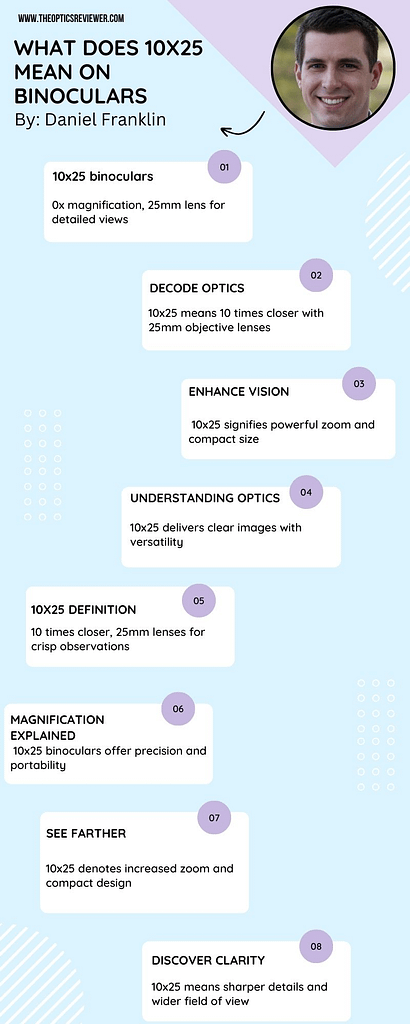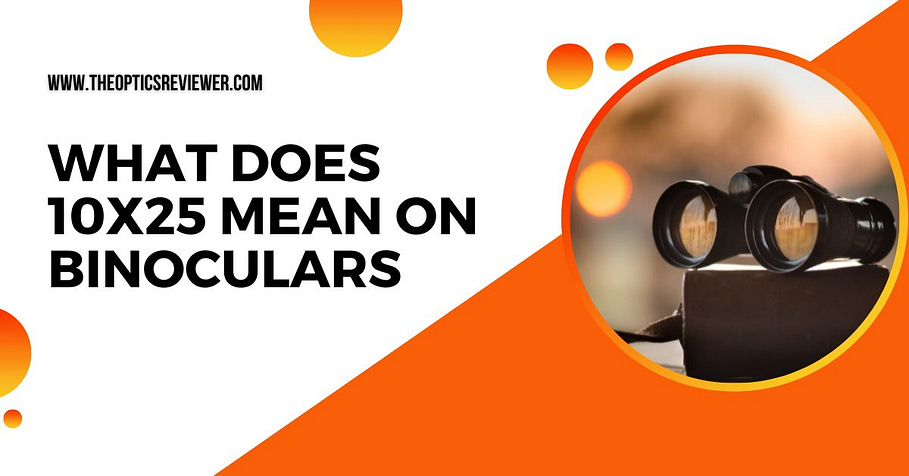Embarking on a journey into the world of binoculars often leads to encountering perplexing numerical combinations like 10×25. Unraveling What Does 10×25 Mean on Binoculars opens a window to a realm of optical possibilities.
Join us as we delve into the significance of 10×25 binoculars, understanding how this numerical duo shapes your viewing experience and unlocks the potential for detailed observations across diverse landscapes and scenarios. Whether you’re a nature enthusiast, sports aficionado, or simply curious about optics, deciphering the meaning of 10×25 adds a fascinating dimension to your optical journey.
Contents
- 1 Key Takeaways
- 2 What Do the Numbers on Binoculars Mean?
- 3 What Does 10×25 Mean on Binoculars?
- 4 Which Type of Binoculars is Better For Birdwatching, 10×25 or 10×42?
- 5 What are the Features of 10×25 Binoculars?
- 6 What are the Uses of 10×25 Binoculars?
- 7 Conclusion
- 8 References
- 9 Frequently Asked Questions
- 9.1 How Do I Choose the Right Binoculars for My Specific Needs?
- 9.2 Can 10×25 Binoculars Be Used for Stargazing?
- 9.3 Are 10×25 Binoculars Suitable For Outdoor Activities Like Hiking and Camping?
- 9.4 What Is the Average Price Range for 10×25 Binoculars?
- 9.5 Are There Any Specific Maintenance or Cleaning Tips for 10×25 Binoculars?
Key Takeaways
- The numbers in binocular specifications represent the magnification power and objective lens diameter.
- 10×25 binoculars have a magnification power of 10 times and an objective lens diameter of 25mm.
- 10×25 binoculars are compact and lightweight, making them ideal for activities like birdwatching and hiking.
- When comparing 10×25 binoculars to 10×42 binoculars, the choice depends on preferences for portability and image quality.
What Do the Numbers on Binoculars Mean?
The numbers on binoculars represent specific specifications that provide essential information about their magnification power and objective lens diameter. When choosing binoculars, two key factors to consider are magnification and objective lens size. The first number in the specifications indicates the magnification power, or how much closer the object will appear compared to the naked eye.
For example, in the case of 10×25 binoculars, the object will appear 10 times closer. The second number represents the objective lens diameter in millimeters. This measurement determines the amount of light that can enter the binoculars, which affects the image brightness and clarity. In this case, the objective lens size is 25mm.

Understanding these binocular specifications is important because it helps determine which type of binoculars is best suited for different activities. For instance, compact binoculars like the 10×25 are lightweight and easy to carry, making them ideal for outdoor adventures such as hiking, birdwatching, or sports events. On the other hand, comparing compact binoculars, the 10×25 offers higher magnification compared to the 8×20, but the latter has a larger objective lens diameter, resulting in brighter images.
To use 10×25 binoculars effectively in different settings, it is recommended to stabilize them by resting your elbows on a solid surface or using a tripod. Adjust the focus wheel until the image appears sharp and clear. Additionally, it is important to be aware that higher magnification can also make image shake more noticeable, so it may be beneficial to use binoculars with image stabilization features. By understanding the numbers on binoculars and using them effectively, you can enhance your viewing experience and fully enjoy various activities.
What Does 10×25 Mean on Binoculars?
Binoculars with a 10×25 specification have a magnification power of 10 times and an objective lens diameter of 25mm. Understanding binocular specifications is crucial when comparing different binocular models and choosing the right binoculars for specific activities. Here’s what you need to know about the 10×25 specification:
- Magnification power: The first number in the specification (10x) indicates the magnification power of the binoculars. In this case, the objects will appear 10 times closer than they would to the naked eye.
- Objective lens diameter: The second number in the specification (25) refers to the diameter of the objective lens in millimeters. The objective lens collects light and determines the brightness of the image. A larger objective lens diameter generally results in a brighter image.
- Understanding binocular specifications: By understanding the magnification power and objective lens diameter, you can compare different binocular models and determine which one suits your needs. For instance, if you’re interested in birdwatching or observing distant objects, a higher magnification power like 10x might be preferable.
- Choosing the right binoculars for specific activities: Different activities require different binocular specifications. For example, if you’re going hiking and want a lightweight and compact option, the 10×25 binoculars would be a good choice due to their smaller size.

Which Type of Binoculars is Better For Birdwatching, 10×25 or 10×42?
For birdwatching enthusiasts, choosing between 10×25 and 10×42 binoculars depends on their preferences for portability and image quality. Both options have their pros and cons, so it’s important to understand the factors to consider when buying binoculars for birdwatching.
If interested you can read more about who makes cabelas binoculars.
10×25 binoculars are compact and lightweight, making them ideal for birdwatchers who prioritize portability. They are easy to carry around and can be conveniently stored in a backpack or pocket. However, their smaller objective lens diameter of 25mm means they have a narrower field of view and may not perform as well in low-light conditions. Additionally, the smaller exit pupil size may make it more challenging to keep the image stable and clear, especially for those with shaky hands.
On the other hand, 10×42 binoculars offer several advantages for birdwatching. With a larger objective lens diameter of 42mm, they provide a wider field of view and gather more light, resulting in brighter and clearer images. The larger exit pupil size also makes it easier to maintain image stability. However, these binoculars are heavier and bulkier, which may be a drawback for birdwatchers who prioritize portability.
When choosing the right binoculars for birdwatching, it’s essential to consider factors such as your specific needs, budget, and personal preferences. Ultimately, the decision between 10×25 and 10×42 binoculars will depend on the trade-off between portability and image quality that best suits your birdwatching experience.
What are the Features of 10×25 Binoculars?
When considering the features of 10×25 binoculars for birdwatching, it is important to understand their compact design and lightweight construction. These features make them highly portable and easy to carry, allowing birdwatchers to take them on extended outdoor excursions without feeling burdened. Here are some notable features of 10×25 binoculars:
- Compact design: 10×25 binoculars are designed to be small and lightweight, making them easy to carry in a pocket or backpack. Their compact size also makes them ideal for situations where space is limited, such as hiking or traveling.
- Lightweight construction: Weighing less than larger binocular models, 10×25 binoculars are comfortable to hold and use for extended periods. This lightweight construction reduces fatigue and ensures that birdwatchers can enjoy their hobby for longer durations without strain.
- Wide field of view: Despite their smaller size, 10×25 binoculars offer a wide field of view, allowing birdwatchers to spot and track birds with ease. This wider view enhances the overall birdwatching experience, enabling enthusiasts to observe birds in their natural habitat more effectively.
- Close focus capability: 10×25 binoculars have the ability to focus on objects at a close distance. This feature is particularly useful when observing small birds or insects, as it allows for detailed and clear views of nearby subjects.
If interested you can read more about when were binoculars invented.
What are the Uses of 10×25 Binoculars?
10×25 binoculars are versatile optical devices commonly used in a wide range of outdoor activities. Their compact size and lightweight design make them ideal for on-the-go use. One of the main uses of 10×25 binoculars is for sporting events. Whether you’re watching a football game or a tennis match, these binoculars allow you to get a closer view of the action, bringing you right into the heart of the game.
Another popular use for 10×25 binoculars is outdoor concerts. By using these binoculars, you can enhance your concert experience by zooming in on the stage and getting a clear view of your favorite performers, even from a distance.
10×25 binoculars are also great for wildlife observation. Whether you’re birdwatching or observing animals in their natural habitat, these binoculars provide a clear and detailed view, allowing you to appreciate the beauty of nature up close.
Furthermore, these binoculars are perfect for hiking and camping trips. They help you navigate through rugged terrains and spot distant landmarks, ensuring a safe and enjoyable outdoor adventure.
Lastly, 10×25 binoculars are great for sightseeing and travel. They allow you to explore new places and capture breathtaking views, making your travel experiences even more memorable.
If interested you can read more about are binoculars allowed on airplanes.
Conclusion
In conclusion, understanding what does 10×25 means on binoculars empowers you to make informed choices for your optics needs. The numbers represent magnification (10x) and objective lens diameter (25mm). This knowledge ensures you select binoculars suited to your preferences, whether for birdwatching, sports, or outdoor adventures.
Embrace the clarity and precision that these specifications offer, enhancing your viewing experiences. So, next time you pick up binoculars, you’ll do so with confidence, appreciating the world through lenses tailored to your vision. Explore the details and embark on a visual journey with binoculars that match your discerning eye.
References
- https://core.ac.uk/download/pdf/212800020.pdf
- https://onlinelibrary.wiley.com/doi/abs/10.1111/j.1755-3768.1978.tb01375.x
- https://onlinelibrary.wiley.com/doi/abs/10.1111/j.1755-3768.1978.tb01375.x
- https://link.springer.com/article/10.1007/BF00229264
Frequently Asked Questions
How Do I Choose the Right Binoculars for My Specific Needs?
When choosing binoculars, it is important to consider whether you need compact or full-size binoculars, as well as factors such as magnification and field of view. Additionally, for outdoor use, look for waterproof and fog-proof options, and consider binoculars with image stabilization technology.
Can 10×25 Binoculars Be Used for Stargazing?
When considering stargazing equipment, it is important to choose the best binoculars for the task. A magnification power of 10x and an objective lens diameter of 25mm make 10×25 binoculars compact and suitable for stargazing. They are also affordable options for enthusiasts.
Are 10×25 Binoculars Suitable For Outdoor Activities Like Hiking and Camping?
The optimal magnification for outdoor activities such as hiking and camping can vary depending on personal preference. Compact binoculars like 10×25 models offer portability and ease of use, making them suitable for such activities. Factors to consider when choosing binoculars for outdoor use include magnification power, objective lens diameter, and overall build quality.
When comparing 10×25 binoculars to other popular models for outdoor activities, it is important to assess their optical performance, durability, and comfort. Enhancing your outdoor experience with the right binoculars involves selecting a model that meets your specific needs and preferences, ensuring clear and detailed views of the surrounding scenery.
What Is the Average Price Range for 10×25 Binoculars?
The average price range for compact binoculars with a 10×25 magnification power and lens size refers to the cost of these binoculars, which typically range from $50 to $150. Factors like durability and construction can impact the price.
Are There Any Specific Maintenance or Cleaning Tips for 10×25 Binoculars?
Maintenance tips for 10×25 binoculars include regular cleaning of lenses with a soft, lint-free cloth, avoiding touching the lenses with bare hands, storing them in a protective case, and addressing common issues like fogging or misalignment through professional servicing.

